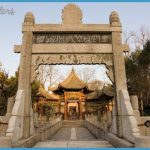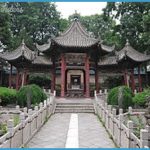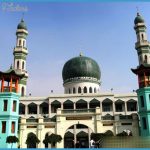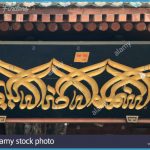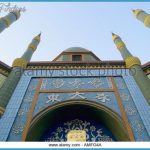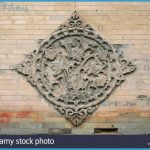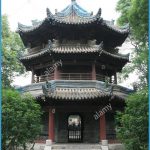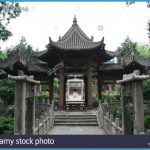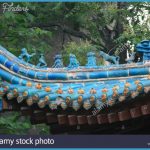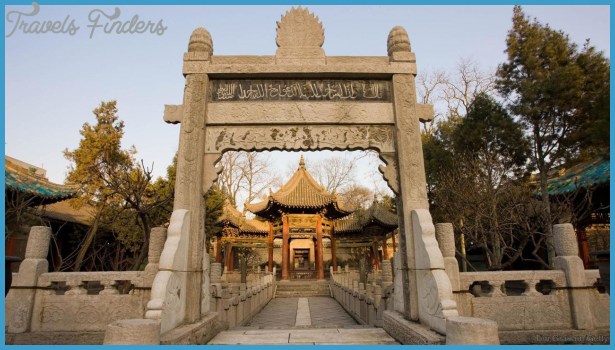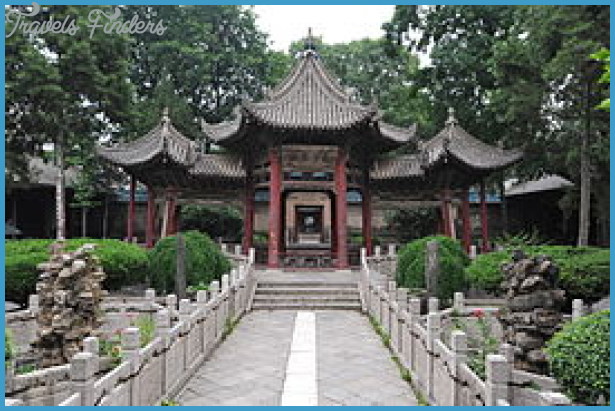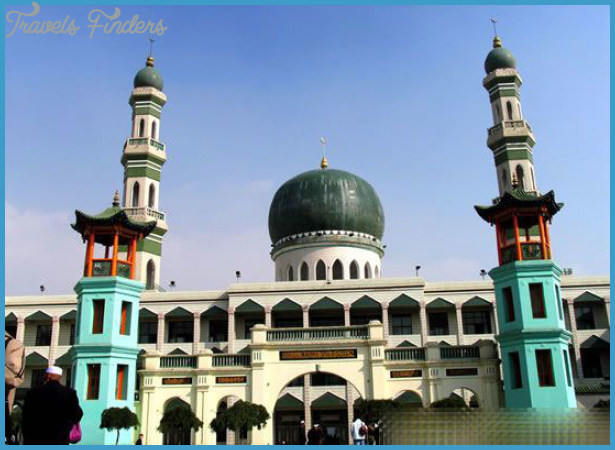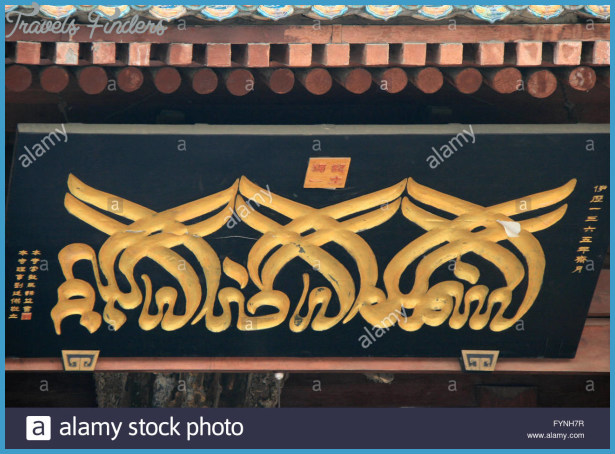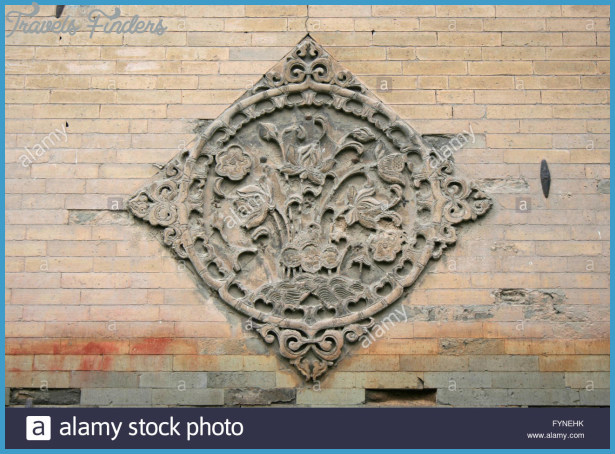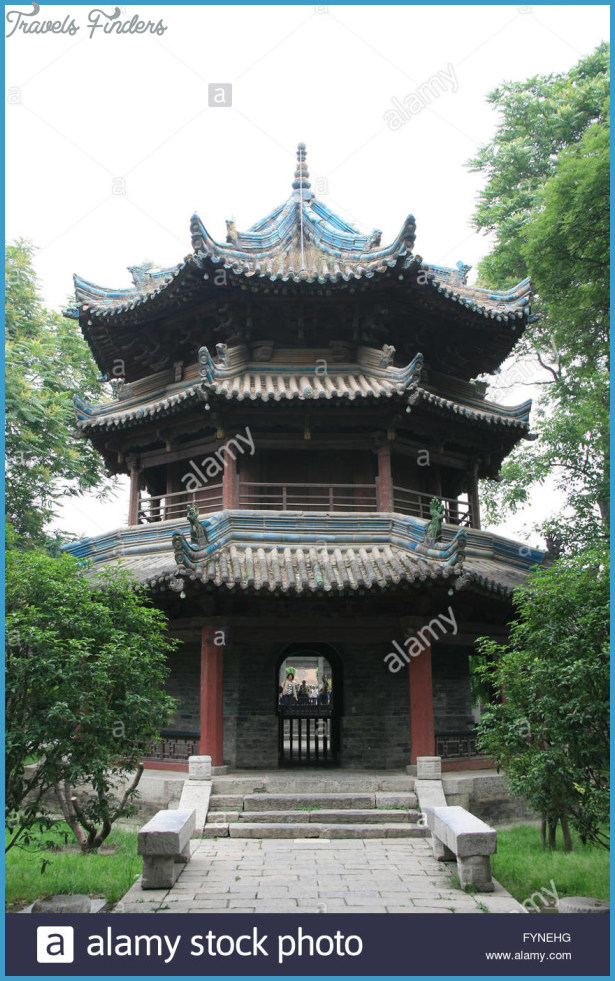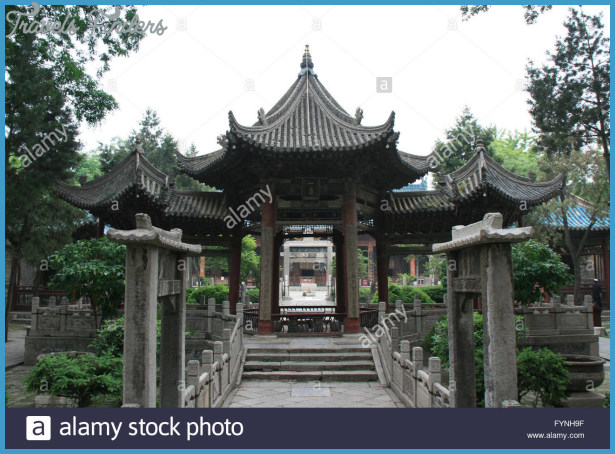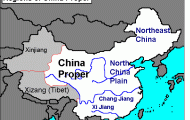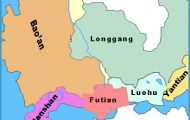In the Cultural Park (Wenhua Gongyuan) in the west of the town stands the Qinyang Gong old Taoist Qinyang Temple, which dates from the Tang period (618-907).
The present buildings are oftheQing period (1644-1911). Note the Pavilion of the Eight Trigrams (Bagua Ting) with its eight stone pillars on which are carved dragon patterns, etc.
The house of Du Fu (712-770; see Famous People), the famous poet of the Du Fu’s Tang dynasty, will be found in the west of the town on a bend of the Thatched
Huanhuaxi river. However, this is not the original thatched building in Cottage which Du Fu lived for four years from 759 to 763, because that one was (Du Fu Caotan9) destroyed in the middle of the Tang era (618-907). The buildings which the visitor will see today are replicas in stone and wood dating from 1500 and 1811 which were restored in 1949. Nevertheless, the house still retains its original name of Du Fu Caotang (Du Fu’s Thatched Cottage).
The complex comprises several sections which portray the life and work of Du Fu. Adjoining it is a beautiful park with little bridges, pavilions and a garden of bamboo.
Chengdu Flower Market
Tomb of Known as “The Eternal Mausoleum” (Yong Ling), the well-preserved tomb
Wang Jian of Wang Jian (847-918), ruler ofthe Early Shu empire, lies in the north-west(Wang Jian Mu) 0f t(-,e town. The 15m/50ft high building, divided into three chambers, was opened up in 1942. In the central chamber will be found the king’s artistically decorated sarcophagus, and in the chamber behind it is a stone statue of Wang Jian.
Manjushri Temple (Wenshu Yuan)
The Manjushri Temple in the north of the town covers an area of 5ha/12V& acres. The complex comprises five temples in wood and stone, and was built in 1691 above the ruins of an earlier monastery dating from the time of the Southern Dynasties (420-589). The Temple of Shuofa Tang houses ten iron statues of Buddhist guardian gods from the Song period (960-1279) and intheCangjing Lou are to be found more than 100 bronze sculptures of Buddhas and Buddhist saints from the Qing era (1644-1911).
Daci Si, in Dongfeng Lu Street, dated originally from the Tang period (618-907), but the present buildings are of theTongzhi period (1862-74). At one time the temple was decorated with some valuable wall-paintings.
Wangjianglou Park and Tower of the View of the River (Wangjianglou Gongyuan)
The park (open; 7.30am-6pm) became well-known through the famous poetess Xue Tao (769-834), who lived here. In the park stands the four-storeyed 30m/100ft high Tower ofthe View of the River (Wangjianglou). A few yards away the visitor can see a fountain from the Tang period (618 907); the famous poetess is said to have used its water to produce the red paper she used and which still bears her name. In the park stand several buildings, all of which are in her memory; these include theTower of Poetic Recitation (Yinshi Lou), the Pavilion ofthe Washing of Paper (Wanjian Ting) and the Tower ofthe Washing of Brocade (Zhou Lou). She was particularly fond of bamboo plants, and a grove of 140 different species of bamboo was laid out in her memory.
The Monastery of Precious Light is to be found in Xindu, a small town 18km/11 miles north-east of Chengdu. It is thought to date from the Han dynasty (24-220). More than twenty buildings (a pagoda, five temples and sixteen courtyards), almost all of which were constructed in 1670, are scattered over an area of 8ha/20 acres. The 13-storey Sarira Pagoda (Sheli Ta) from the Tang period (618-907) has survived. Archaeologicaily valuable items on display include a stone tablet with 1000 Buddha reliefs (a.d. 540) and 500 larger-than-life terracotta statues from the Qing period (1644 1911), which depict Luohans in an individual manner.
The irrigation system to be found near the town of Guanxian on the upper reaches of the Minjian river, 55km/34 miles north-west of Chengdu, was constructed in 250 b.c. by Li Bing, prefect of Sichuan at the time of the Warring Kingdoms, in order to prevent catastrophic flooding. He ordered the river to be divided up by means of earth dams, with one section branching out into tributaries and canals which served to irrigate the fields. The whole complex is made up of the “Fish’s Jaws” (Yuzhui), which functions as a watershed and dyke, the weir known as “Flying Sands” (Feisha Yan) and the canal, the “Neck of the Precious Bottle” (Baoping Kou). This ingenious system has meant that the Minjian has never again flooded its banks during the last 2200 years, and the Chengdu Plain of central Sichuan has become one of China’s most fertile regions.
On Mount Yulaishan, on the east bank of Minjiang, can be seen the imposing Temple of the Two Kings, built in the Qing period (1644-1911) on the ruins of an earlier 6th c. edifice. Statues of the creators of the irrigation system, Li Bing and his son Li Erlang, stand in the halls of the temple.
Atthe northern tip of a small island in the river, on a mound at the mouth of the “Neck of the Precious Bottle” canal, stands another building of historic importance, the Temple of the Slayer of the Dragon. According to legend, the reason the Minjiang river had flooded its banks so often was that a wicked dragon had its lair in the waters. Li Bing and his son succeeded in chaining the dragon so that there was no longer any fear of floods. It is uncertain when thefirsttemple was built here in honour of the slayer of the dragon; it is only known that the present building dates from the Qing period (1644-1911). The impressive stone statue of Li Bing dates from the year 168; it stands 2-0m/91/2ft high, weighs 4V& tonnes, and was salvaged from the river in 1974. An inscription on the breast shows the year and month in which it was sculpted.
16km/10 miles south-west of the Dujiangyan irrigation complex soars Mount Qingchengshan, with its 37 peaks. It is one of China’s Taoist pilgrimage shrines. Some impressive palaces, towers and pavilions are scattered over this scenically beautiful mountain.
At the foot of Mount Qingchengshan stands the Taoist Palace of the Creation of Good Fortune (Jianfu Gong), which dates back to the Tang period (618-907). The present buildings were erected in 1888.
Tradition has it that Zhang Daoling, the legendary founder of the Taoist religion, taught in a cave in this mountain. Since then it has been called the Cave of the Heavenly Master. The temple dates from the Sui period (589 618), but was rebuilt at the end of the Qing dynasty (1644-1911). Visitors can see a terracotta likeness of Zhang Daoling and three 90cm/3ft statues dating from 723 and representing Fuxi, Shengong and Xianyuan, three rulers said to lived in China in prehistoric times.
Built between 1860 and 1870, the Temple of the Utmost Purity stands majestically on the Laoxiao Ding mountain peak. It replaced a much older 3rd c. building which burned down in the mid-17th c.

